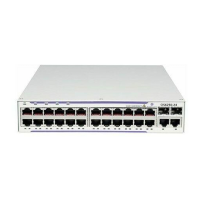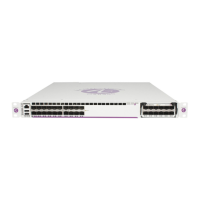Schedulers
Page 78 7210 SAS D, E, K OS Quality of Service Guide
particular queue be considered to be a part of a hybrid Strict + WDRR configuration. If a
weight value of 1 is given for queue 1 and 5 is given for queue 2, then we will see traffic
out of the port in the ratio of 1:5 between the queues (1 and 2), provided no traffic is
flowing in the other queues. A weight value of 1 will actually pump out 2Kbytes from that
queue, a value of 5 will pump out 10 Kbytes. Twice of the weight value given will be
pumped out.
• Strict + WRR/WDRR — If the WRR/WDRR weight associated with a particular CoS
queue is set to strict, the queue is considered to be in a strict priority mode. This set of
strict priority queues is serviced first in the order of their CoS numbering (higher
numbered CoS queue receives service before smaller numbered queues). In this mode, the
scheduler services the strict queues first and then the queues configured with weights in
both the CIR and PIR loop. The scheduler ensures that it meets the CIR of all the queues
(both strict queues and queues with weight), if bandwidth is available before scheduling
the queues in the PIR loop. If multiple queues are configured as strict, the higher-priority
strict queues are serviced first before the lower priority strict queues in both the CIR and
the PIR loop. The weights configured for the queues are only considered during the PIR
loop.
Scheduler on 7210 SAS-K
Supports Strict Priority and WFQ mode of scheduling or a mix of both. Schedulers are used at
SAP ingress, SAP egress, Access Uplink Port ingress and Access-uplink port egress.
The scheduler uses 2 loops - the CIR loop and PIR loop, each with 4 priorities. The configured
priority of the queue determines the service order of the queue in the CIR loop and the PIR loop.
The scheduler first goes through the CIR loop, where it services all the queues which are operating
at less than CIR rate according to their priority (that is, higher priority queues get services earlier
than lower priority queues). It then goes through the PIR loop, where it services all the queues
which are operating above the CIR rate (but less than PIR rate) according to their priority (that is,
higher priority queues get services earlier than lower priority queues). If there are multiple queues
configured with the same priority, in the CIR loop the queues are scheduled using WFQ, with the
configured weight (that is, pir-weight) of the queue used to determine the proportion of the
available bandwidth that is given to the queue. In the PIR loop, the queues are scheduled using
WFQ, with the configured weight (that is, pir-weight) of the queue used to determine the
proportion of the available bandwidth that is given to the queue (using WFQ). For more
information, see Chapter , QoS Port Scheduler Policies for 7210 SAS-M and 7210 SAS-T, on page
449

